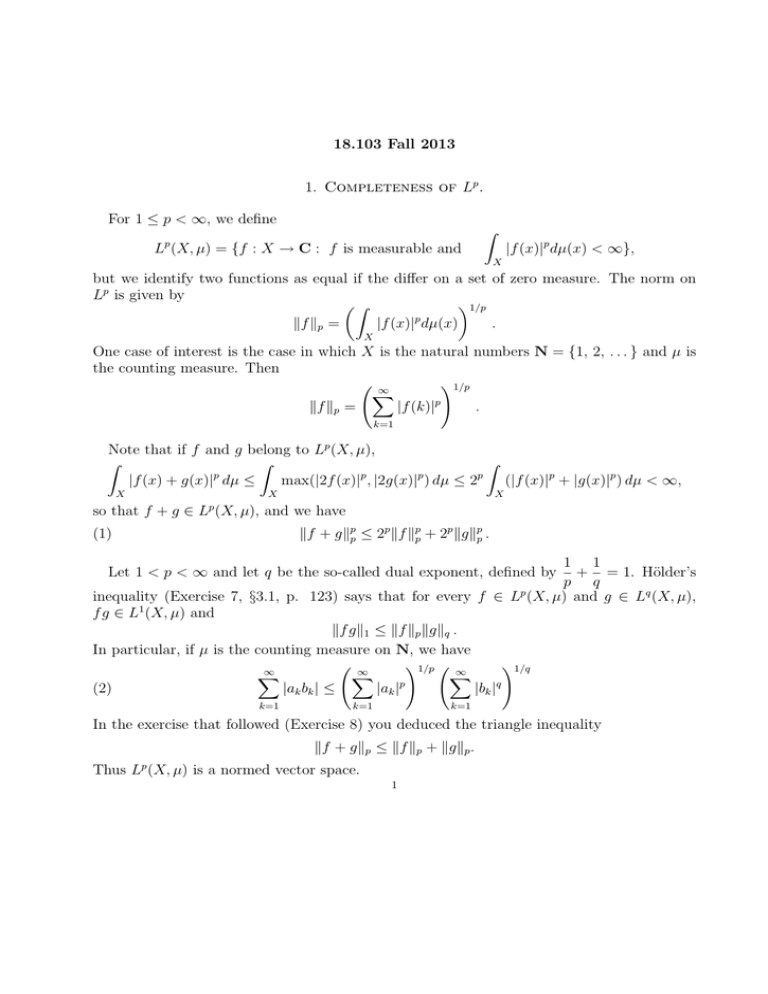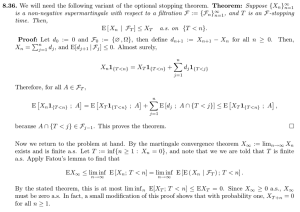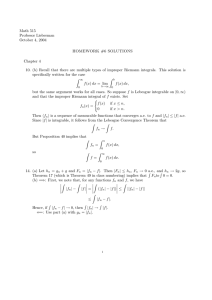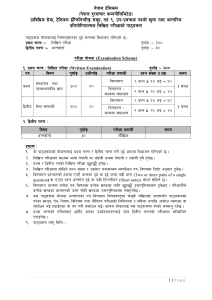18.103 Fall 2013 1. Completeness of L .
advertisement

18.103 Fall 2013
1. Completeness of Lp .
For 1 ≤ p < ∞, we define
Z
p
|f (x)|p dµ(x) < ∞},
L (X, µ) = {f : X → C : f is measurable and
X
but we identify two functions as equal if the differ on a set of zero measure. The norm on
Lp is given by
Z
1/p
p
kf kp =
|f (x)| dµ(x)
.
X
One case of interest is the case in which X is the natural numbers N = {1, 2, . . . } and µ is
the counting measure. Then
!1/p
∞
X
kf kp =
|f (k)|p
.
k=1
Note that if f and g belong to Lp (X, µ),
Z
Z
Z
p
p
p
p
|f (x) + g(x)| dµ ≤
max(|2f (x)| , |2g(x)| ) dµ ≤ 2
(|f (x)|p + |g(x)|p ) dµ < ∞,
X
X
X
p
so that f + g ∈ L (X, µ), and we have
kf + gkpp ≤ 2p kf kpp + 2p kgkpp .
(1)
1 1
+ = 1. Hölder’s
p q
inequality (Exercise 7, §3.1, p. 123) says that for every f ∈ Lp (X, µ) and g ∈ Lq (X, µ),
f g ∈ L1 (X, µ) and
kf gk1 ≤ kf kp kgkq .
In particular, if µ is the counting measure on N, we have
!1/p ∞
!1/q
∞
∞
X
X
X
(2)
|ak bk | ≤
|ak |p
|bk |q
Let 1 < p < ∞ and let q be the so-called dual exponent, defined by
k=1
k=1
k=1
In the exercise that followed (Exercise 8) you deduced the triangle inequality
kf + gkp ≤ kf kp + kgkp .
p
Thus L (X, µ) is a normed vector space.
1
2
Theorem 1. For 1 ≤ p < ∞, Lp (X, µ) is a Banach space.
The fact that k · kp is a norm follows from Exercise 8. Here we show that the space is
complete. Consider a Cauchy sequence fn , i. e.,
kfn − fm kp → 0 as
m, n → ∞
Choose n1 < n2 < · · · such that
kfn − fm kp ≤ 2−2j ,
for all m, n ≥ nj
Let gj = fnj and hk = gk+1 − gk . Note that
Z
|hk |p dµ = khk kpp ≤ 2−2pk
X
The only difference between this proof of completeness and the one in the text is the way
we show that
∞
X
hk (x)
k=1
converges almost everywhere. By (2) applied to ak = |hk (x)|2k/p , bk = 2k/p ,
!1/p ∞
!1/q
∞
∞
∞
X
X
X
X
ak bk ≤
2k |hk (x)|p
2−kq/p
|hk (x)| =
k=1
k=1
k=1
k=1
Let
C=
∞
X
!1/q
2−kq/p
<∞
k=1
It follows from the monotone convergence theorem that
!p
Z
Z X
∞
∞
∞
X
X
k
p
p
p
2 |hk (x)| dµ ≤ C
2k 2−2kp < ∞
|hk (x)|
dµ ≤ C
X
k=1
X k=1
Therefore,
∞
X
k=1
!p
|hk (x)|
<∞
k=1
P
for almost every x. For such x, the series
hk (x) is absolutely convergent, and we can
define
∞
X
f (x) = g1 (x) +
hk (x) = lim gn (x)
k=1
n→∞
Set f (x) = 0 on the exceptional set of measure 0 where the limit does not exist.
3
The remaining parts of the argument are nearly the same as in the case of L1 . By Fatou’s
lemma, for k fixed,
Z
Z
Z
p
p
−2kp
|gj (x) − gk (x)| dµ ≥
lim inf |gj (x) − gk (x)| dµ =
|f (x) − gk (x)|p dµ
2
≥ lim inf
j→∞
X
j→∞
X
X
In other words,
kf − gk kp ≤ 2−2k
In particular, for k = 1 we have f − g1 ∈ Lp (X, µ) and hence f = (f − g1 ) + g1 ∈ Lp (X, µ).
Finally, for all n ≥ nk ,
kfn − f kp ≤ kfn − gk kp + kgk − f kp ≤ 2−2k+1
The space L∞ (X, µ) is defined (with the usual equivalence) as the set of measurable
functions such that
kf k∞ = ess supX |f (x)| = inf
sup
E x∈(X−E)
|f (x)| < ∞
where the infimum is taken over all sets E of measure zero. The expression on the right is
known as the essential supremum (supremum ignoring sets of measure zero).
Exercise. Show that L∞ (X, µ) is a Banach space. (This does not require an accelerated
Cauchy sequence. The main issue is to identify the exceptional set of measure zero on which
the convergence may fail.)
2. Density in Lp
The space C0∞ (Rn ) denotes all infinitely differentiable functions on Rn that are zero outside
a compact set.
Theorem 2. C0∞ (Rn ) is dense in Lp (Rn ) for 1 ≤ p < ∞.
Proof. Step 1. Approximation of 1[0,1] . To accomplish this we will find for each , 0 < < 1/2,
a function h ∈ C0∞ (R) satisfying 0 ≤ h(x) ≤ 1 for all x, h (x) = 1 for ≤ x ≤ 1 − , and
h (x) = 0 for all x ∈
/ [0, 1]. It follows that
Z
p
k1[0,1] − h kp =
|1[0,1] − h (x)|p dx ≤ 2
R
Start by defining
(
e−1/x
f (x) =
0
x>0
x≤0
4
Then f is infinitely differentiable and f (x) → 1 as x → ∞. The function g(x) = f (x)f (1−x)
belongs to C0∞ (R) is zero outside [0, 1] and satisfies 0 < g(x) < 1 in 0 < x < 1. Denote
Z 1
c=
g(x) dx
0
and define
Z
1 x
G(x) =
g(t) dt.
c 0
Then G ∈ C ∞ (R), 0 ≤ G(x) ≤ 1 for all x, G(x) = 0 for all x ≤ 0, G(x) = 1 for all x ≥ 1.
Finally, let
h (x) = G(x/)G((1 − x)/).
Then 1[,1−] ≤ h ≤ 1[0,1] , and hence k1[0,1] − h kp ≤ (2)1/p → 0 as → 0.
Step 2. Approximate 1R for rectangles R = I1 × I2 × · · · × In , Ij = [aj , bj ] by
n
Y
h ((x − aj )/(bj − aj ))
j=1
Step 3. Approximate 1E in case E is a measurable subset of Rn of finite measure.
Taking sums of functions from Step 2, one can approximate 1R by functions in C0∞ (Rn )
for any R in the rectangle ring (finite union of rectangles). By Theorem 20 (§1.3, p. 34 of
the textbook), µ(E) < ∞ implies E ∈ MF . Hence there is a sequence Rk in the rectangle
ring such that
µ(S(E, Rk )) → 0 as k → ∞
where S(A, B) = (A − B) ∪ (B − A), the set-theoretical symmetric difference. Moreover,
k1E − 1Rk kpp = µ(S(E, Rk )), so 1Rk tends to 1E in Lp (Rn ) for any p, 1 ≤ p < ∞.
Step 4. From Step 3, we can approximate any finite linear combination of functions of the
form 1E with µ(E) < ∞ in Lp (Rn ) norm by functions in C0∞ (Rn ). Finally, consider any
measurable f : Rn → C. Then f = u + iv = (u+ − u− ) + i(v + − v − ), and we may apply
Theorem 6 (§2.2, page 62) to each of the functions u± and v ± to find a sequence of simple
functions sk such that
lim sk (x) = f (x), |sk (x)| ≤ |f (x)|.
k→∞
+
Note that if 0 ≤ s ≤ u and s is simple, then for any c > 0,
1
µ({x ∈ R : s(x) = c}) ≤ µ({x ∈ R : |f (x)| ≥ c}) ≤ p
c
n
p
n
n
Z
|f |p dµ < ∞.
Rn
for f ∈ L (R ). Thus sk is a linear combination of indicator functions 1E with µ(E) < ∞,
and hence each sk can be approximated, (Thanks to S. M. for pointing out the gap in
5
the preceding version in which we forgot to check this finiteness property of sk .) Finally,
|sk (x) − f (x)|p ≤ (2|f (x)|)p is a majorant, and the dominated convergence theorem implies
Z
lim
|f (x) − sk (x)|p dx = 0.
k→∞
This concludes the proof that
Rn
∞
C0 (Rn )
is dense in Lp (Rn ).
MIT OpenCourseWare
http://ocw.mit.edu
18.103 Fourier Analysis
Fall 2013
For information about citing these materials or our Terms of Use, visit: http://ocw.mit.edu/terms.






